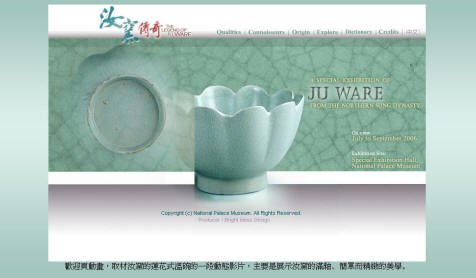 |
 |
||||||||||||||||||||||||||||||||||||||||||||||||||||||||||
|
|
|||||||||||||||||||||||||||||||||||||||||||||||||||||||||||
|
“The Legend of Ju Ware” website The
National Palace Museum, Taiwan Ju ware ceramics from the early 12th century, produced during the latter years of the Northern Sung dynasty, are distinguished by their subtle sky-blue colour and lustre of their glazes. They have become highly coveted pieces collected by ceramic connoisseurs and aficionados ever since the Southern Sung period. Examples of Ju ware are extremely rare with only less than 70 works surviving today. The National Palace Museum’s collection of Ju ware totals some 21 pieces; many of these are truly unique in shape. “The Legend of Ju Ware” website, focused on the Museum’s impressive collection of Ju ceramics, along with the addition of information about pertinent wares from the National Palace Museum or other museums in the world and with the aid of advanced multimedia technology, endeavours to narrate the fascinating story behind this paragon of celadon ware. The content will be divided into the following five major categories: “Qualities”, “Connoisseurs”, “Origin”, “Explore” and “Dictionary”:
1. Exciting Content Archaeological evidence, academic research and scholarship on Ju wares to date will be presented in its entirety in this website. The first two sections “Qualities” and “Connoisseurs” will divulge the inimitable lustre for which Northern Sung Ju wares are so renowned as well as the reasons behind Ju wares being crowned the epitome of Sung wares from the time of Sung until Ming and Ch’ing. “Qualities,” includes four subcategories dealing with Glaze: The Story Behind the Glaze Colour, Shape: The Features of its Forms, Technique: Its Extraordinary Techniques and History: Its Development. This section introduces the tradition of and advances in Ju wares in terms of glaze colour, forms and firing techniques within the framework of the historical development behind Chinese ceramics. “Connoisseurs” includes four subcategories dealing with Trends: The Refined Tastes of the Period in which it was Produced, Spread: Interaction between Ceramics at the time, Ming Literati: The Refined Appreciation of Scholars and Ch’ing court: The Ch’ien-lung Emperor’s Treasures in the Ch’ing Dynasty. This section presents the cultural exchange and artistic influences between high quality Ju ware ceramics and Koryo celadons of Korea. Examples of Ju wares collected in other museums will be included. The appreciation and connoisseurship of Ju ware pursued by lofty scholars and emperors from the Ming and Ch’ing dynasties will also be highlights in this section. 2. Latest Archaeological Excavation On-site Footage During the period between 1987 and 2001, the exact site of the kiln where these precious Ju wares were fired was successfully located. The sections Kiln Discovery and Kiln Reconstruction offer seven short videos of the actual Ju ware kiln site in Pao-feng county, Henan province, China. Interviews were held with relevant personnel allowing viewers to further understand the details behind the production and firing of these ceramics. 3. Three-dimensional Experience, Shattering the Restrictions of Two-dimensionality Ceramics are three-dimensional objects with depth, volume and shape. However, images printed on paper can only provide one single view of the piece. The section “Explore” includes a function where 360-degree appreciation of these ceramics provided by 3D digital photography is presented. The vessel will be presented in its full, complete form and zooming options on the surface or the bottom will also be available. Within the monitor of any computer, the viewer can handle in simulated space. Furthermore, the section will provide fundamental information on the vessels as well as imperial poems or biographies, etc. 4. Copious reference material, Facilitates Access to Information and Learning Rich and thorough resources and materials for reference purposes are provided so that specialists, enthusiasts or the general public can all easily access information about these important Ju wares and independently gain expertise about them. “Dictionary” encompasses nine sections including Portraying the Ju Ware Kiln Site, Ju Ware in the World, Ju Ware Close-up, Poems by the Emperor Ch’ien-lung, Imperial Household Archives of the Ch’ing Court, Mentions of Ju Ware in Historical Documents, Chinese, English, and Japanese Bibliography, Text Version and The Applications of Ju Wares in Modern Daily Life. “The Legend of Ju Ware” website includes a wealth of information and boasts a 360-degree approach to appreciation, thereby overcoming the limitations of actual display. We earnestly hope that users, after viewing these webpages, will leave with a broad sense and deep understanding of the beauty, classicism and significance behind Ju ware ceramics.
|
|
